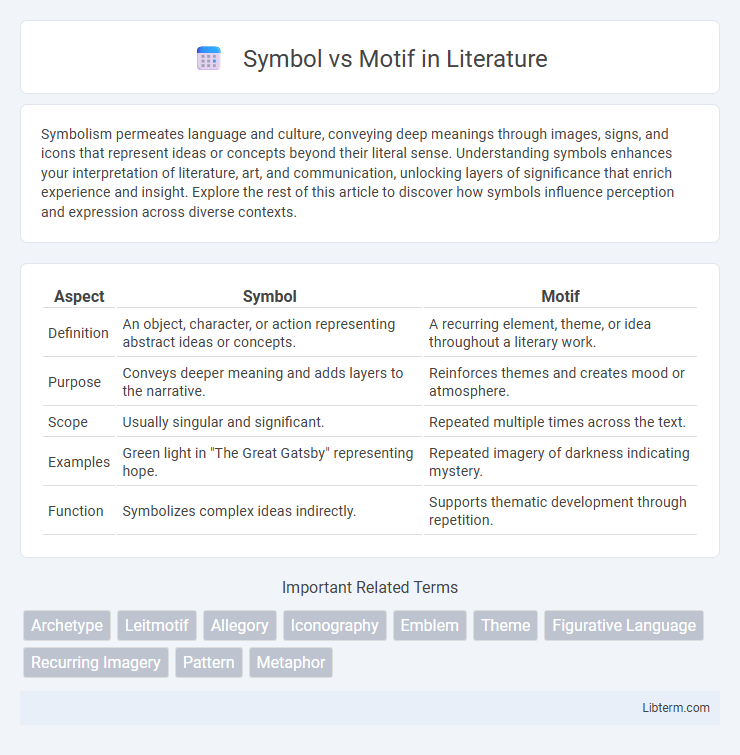Symbolism permeates language and culture, conveying deep meanings through images, signs, and icons that represent ideas or concepts beyond their literal sense. Understanding symbols enhances your interpretation of literature, art, and communication, unlocking layers of significance that enrich experience and insight. Explore the rest of this article to discover how symbols influence perception and expression across diverse contexts.
Table of Comparison
| Aspect | Symbol | Motif |
|---|---|---|
| Definition | An object, character, or action representing abstract ideas or concepts. | A recurring element, theme, or idea throughout a literary work. |
| Purpose | Conveys deeper meaning and adds layers to the narrative. | Reinforces themes and creates mood or atmosphere. |
| Scope | Usually singular and significant. | Repeated multiple times across the text. |
| Examples | Green light in "The Great Gatsby" representing hope. | Repeated imagery of darkness indicating mystery. |
| Function | Symbolizes complex ideas indirectly. | Supports thematic development through repetition. |
Introduction to Symbol vs Motif
Symbols represent deeper meanings beyond their literal sense, often embodying abstract ideas or concepts within literature and art. Motifs are recurring elements, such as images, phrases, or themes, that reinforce the central message or mood throughout a work. Understanding the distinction between symbols and motifs enhances interpretation by identifying how recurring elements contribute to overall thematic development.
Defining Symbols in Literature
Symbols in literature represent objects, characters, or actions that convey deeper meanings beyond their literal sense, often embodying abstract concepts such as freedom, love, or death. Unlike motifs, which are recurring elements that reinforce themes, symbols carry specific significance and are strategically integrated to provoke emotional or intellectual responses from readers. Effective literary symbols enrich narratives by linking tangible details to universal ideas, creating layers of interpretation.
Understanding Motifs in Storytelling
Motifs in storytelling are recurring elements, such as images, sounds, or themes, that reinforce the narrative's central ideas and emotional tone. Unlike symbols, which represent a specific concept or idea, motifs help build atmosphere and foreshadow events through repetition and variation, deepening the audience's engagement and understanding. Recognizing motifs enhances the reading experience by revealing underlying patterns and supporting the story's thematic cohesion.
Key Differences Between Symbol and Motif
Symbols represent abstract ideas or concepts through specific objects or images, often carrying a deeper meaning unique to a particular work or culture. Motifs are recurring elements, such as patterns, images, or themes, that reinforce and develop the overarching message or mood throughout a literary or artistic work. Unlike symbols, motifs do not necessarily stand for a single abstract idea but work collectively to build the narrative or thematic structure.
Symbolism: Functions and Effects
Symbolism serves as a powerful literary device that conveys deeper meanings beyond the literal sense, enabling writers to evoke complex emotions and ideas through specific symbols. Symbols function as tangible representations of abstract concepts, enriching narrative layers and fostering readers' interpretive engagement by linking concrete images to universal themes. The effects of symbolism include creating resonance, enhancing thematic depth, and facilitating cultural or psychological connection, thus making stories more impactful and memorable.
Motifs: Role and Recurrence
Motifs play a crucial role in literature by reinforcing themes and enhancing the narrative's emotional impact through repeated elements or patterns. Their recurrence creates coherence and deepens meaning, guiding readers to recognize underlying messages without overt explanation. Unlike symbols, motifs emphasize the process of development and thematic exploration across a work, making them essential for thematic unity.
Examples of Symbols in Classic Works
In classic literature, symbols often represent deeper meanings beyond their literal sense, such as the green light in F. Scott Fitzgerald's "The Great Gatsby," symbolizing hope and the American Dream. Another iconic example is the conch shell in William Golding's "Lord of the Flies," representing law, order, and civilization. These symbols enhance thematic depth and provide insight into the characters' internal and external conflicts.
Examples of Motifs in Literature
Motifs in literature are recurring elements, such as images, phrases, or situations, that reinforce the central themes of a work, distinguishing them from symbols that often represent deeper, singular meanings. Classic examples include the green light in *The Great Gatsby* symbolizing unattainable dreams, repeated references to the conch in *Lord of the Flies* representing order and civilization, and the motif of darkness and light in *Macbeth* illustrating the struggle between good and evil. These motifs deepen narrative complexity by emphasizing underlying messages through persistent repetition across the text.
How to Identify Symbols and Motifs
Symbols are objects, characters, or colors that represent abstract ideas or concepts, while motifs are recurring elements or themes that reinforce a work's central ideas. To identify symbols, look for specific items or figures consistently associated with deeper meanings beyond their literal sense, often emphasized through repetition or context. Motifs can be spotted by tracking repeated patterns, phrases, or images that highlight the underlying themes throughout a narrative or artwork.
The Impact of Symbol and Motif on Narrative
Symbols and motifs enhance narrative depth by embedding layered meanings that resonate throughout a story. Symbols represent abstract concepts tangibly, allowing readers to interpret themes on multiple levels, while motifs provide recurring elements that reinforce the story's central ideas and emotional tone. This interplay between symbol and motif shapes the reader's understanding, creating a cohesive and immersive narrative experience.
Symbol Infographic

 libterm.com
libterm.com